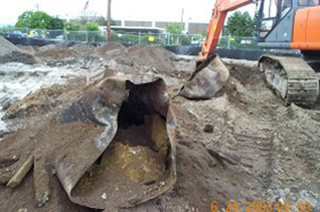
Image from EPA clean up of the Frontier Hard Chrome, Inc. Superfund site. Two buried tanks apparently used to store chromium solutions were found buried under the northern half of the FHC building. (Image courtesy of the U.S. Environmental Protection Agency.)
Instructor(s)
James Hamilton
MIT Course Number
11.370
As Taught In
Fall 2005
Level
Graduate
Course Description
Course Highlights
This course features a full set of readings and an example of a completed student project in the assignments section.
Course Description
There are several hundred thousand Brownfield sites across the country. The large number of sites, combined with how a majority of these properties are located in urban and historically underserved communities, dictate that redevelopment of these sites stands to be a common theme in urban planning for the foreseeable future. Students form a grounded understanding of the Brownfield lifecycle: how and why they were created, their potential role in community revitalization, and the general processes governing their redevelopment. Using case studies and guest speakers from the public, private and non-profit sectors, students develop and hone skills to effectively address the problems posed by these inactive sites.


